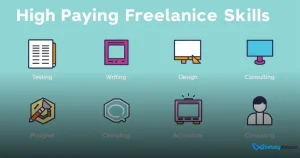Are you interested in exploring profitable side hustles?
You’re not alone! Many individuals are seeking lucrative ways to supplement their income while maintaining their primary job.
Understanding Profitable Side Hustles
To start, understanding profitable side hustles means knowing the balance between your time and money.
A side hustle allows you to earn extra income while often doing something you love.
Keep in mind that not all side hustles are created equal, and some may offer better rewards than others.
What Makes a Side Hustle Profitable?
A profitable side hustle can be defined by its potential to generate income relative to the time and effort put in.
Factors to consider include market demand, startup costs, and the skills you possess. Look for opportunities that align with your interests and expertise.
This way, you’re more likely to stick with it.
Types of Profitable Side Hustles
There are many types of side hustles available, such as:
- Freelancing: Utilize your skills in writing, graphic design, or programming on platforms like Upwork and Fiverr.
- Online Tutoring: Teach a subject you’re passionate about through various online platforms.
- Handmade Crafts: Create unique products to sell on websites like Etsy.
Researching Opportunities
Research is crucial when diving into side hustles. Explore popular trends and see what others in your field are doing.
Online forums and social media can be great resources to understand what’s in demand.
As you explore profitable side hustles, remember that persistence and adaptability are key.
Adjust your strategies as you learn more about what works best for you.
Top 5 Most Profitable Side Hustles
When exploring profitable side hustles, it’s essential to know which options can yield the best returns.
Here are the top 5 most profitable side hustles:
1. Freelancing
Freelancing allows you to use your skills, such as writing or graphic design, on a project basis.
Platforms like Upwork and Fiverr connect you with clients needing specific services.
As you build your portfolio, your earnings can significantly increase.
2. Online Tutoring
If you are proficient in a particular subject, consider becoming an online tutor.
Websites like Tutor.com and VIPKid allow you to teach students from around the world, providing a flexible schedule and good pay.
3. Dropshipping
With dropshipping, you can sell products online without having to hold inventory.
You simply set up an online store, and when customers make purchases, you order those products from a third party.
This model can lead to high profits if marketed well.
4. Social Media Management
Many businesses require help with their social media presence.
By managing their accounts and creating content, you can earn a good income.
This side hustle capitalizes on your knowledge of platforms like Instagram and Facebook.
5. Affiliate Marketing
Affiliate marketing involves promoting products and earning a commission for every sale made through your referral.
By sharing links on your blog or social media, you can generate passive income while engaging your audience.
Identifying the right side hustle for you hinges on your interests and available time.
Each of these options has the potential to be quite rewarding!
How to Choose the Right Side Hustle for You

Choosing the right side hustle is important for maximizing your earnings. Here are steps to help you find the best fit for you:
1. Assess Your Skills and Interests
Start by making a list of your skills and hobbies.
Think about what tasks you enjoy and what you are good at. This can guide you toward a hustle that you will be passionate about.
2. Evaluate Your Time Availability
How much time can you dedicate to a side hustle? Make a realistic estimate of the hours you can spare each week.
Some hustles require more commitment than others, so find a balance that fits your schedule.
3. Research Market Demand
Before committing to a side hustle, research its market demand. Are people interested in the services or products you can offer?
Websites like Google Trends and social media can give you insights into what is trending and in demand.
4. Determine Your Financial Goals
Establish how much money you want to make from your side hustle.
Setting clear financial goals will help you stay focused and measure your progress over time.
5. Start Small
When you choose a side hustle, it’s often wise to start small.
This allows you to assess whether it’s a good fit without investing too much time or money upfront. You can always expand later if it proves successful.
6. Consider Growth Potential
Look for side hustles that have room for growth.
Some opportunities may begin as part-time work but can evolve into full-time income if they gain traction.
Think about how you can turn your hustle into something bigger.
7. Seek Feedback
Once you’ve started your side hustle, seek feedback from customers and peers.
This can help you improve your services, understand your audience better, and make your hustle more profitable.
Setting Goals for Your Side Hustle
Setting goals for your side hustle is vital to track your progress and stay motivated. Here are some steps to help you set effective goals:
1. Define Your Vision
Start by asking yourself what you want to achieve with your side hustle.
Do you want to earn extra income, build a brand, or eventually turn it into a full-time job? Having a clear vision will guide your goal-setting process.
2. Set SMART Goals
Utilize the SMART criteria to create your goals:
- Specific: Make your goals clear and specific to understand exactly what you want to achieve.
- Measurable: Set criteria to measure your progress and success. For example, “I want to earn $500 a month”.
- Achievable: Ensure your goals are realistic and attainable given your current resources and time.
- Relevant: Choose goals that truly matter to your side hustle and align with your overall vision.
- Time-bound: Assign a deadline to your goals to create a sense of urgency.
3. Break Goals into Smaller Tasks
Once you have set your main goals, break them down into smaller, manageable tasks.
This makes it easier to stay on track and celebrate small wins along the way.
4. Review and Adjust Regularly
Set aside time to regularly review your goals and progress.
If you find that your goals are too easy or too hard, adjust them accordingly. Flexibility is key to staying motivated and engaged.
5. Stay Accountable
Share your goals with friends, family, or fellow hustlers.
Having someone to hold you accountable can motivate you to keep striving toward your objectives.
Tools to Manage Your Side Hustle Effectively
Managing your side hustle effectively requires the right tools to stay organized and focused. Here are some essential tools that can help you succeed:
1. Task Management Tools
Using tools like Trello or can help you keep track of your tasks. You can create boards for different projects, set deadlines, and assign tasks to yourself.
This visual organization keeps you focused on your goals.
2. Time Tracking Software
To understand how you spend your time, consider using time tracking tools like Toggle or Clockify.
These applications allow you to track the hours you work on various tasks, helping you recognize where your time goes so you can improve efficiency.
3. Financial Management Apps
Managing finances is crucial for your side hustle. Use apps like QuickBooks or Mint to track income, expenses, and budgeting.
These tools can simplify tax preparation and offer insights into your financial health.
4. Communication Tools
If you work with clients or collaborators, communication tools like Slack or Zoom are essential.
They make it easy to stay connected, share files, and hold discussions without unnecessary delays.
5. Marketing Tools
For promoting your side hustle, consider using tools like Hootsuite or Mailchimp.
These platforms help you schedule social media posts and manage email marketing campaigns effectively.
Reaching your audience is a key aspect of growing your hustle.
6. Cloud Storage Services
Keep your important documents and files organized by using cloud storage like Google Drive or Dropbox.
This allows you to access your files from anywhere, making collaboration easier and securing your data.
By leveraging these tools, you can better manage your side hustle and ensure it operates smoothly.
Marketing Your Side Hustle Online

Marketing your side hustle online is crucial for reaching new customers and growing your business. Here are some effective strategies:
1. Build a Professional Website
Having a website is essential for showcasing your products or services.
Use platforms like Wix or WordPress to create a user-friendly site that highlights your offerings and includes contact information.
2. Utilize Social Media
Social media platforms like Instagram, Facebook, and Twitter are powerful tools for marketing.
Share engaging content, promotions, and updates to connect with your audience. Be consistent in posting to keep followers engaged.
3. Leverage Email Marketing
Email marketing allows you to reach customers directly. Build an email list by offering a discount or freebie in exchange for subscribers.
Use tools like Mailchimp or Constant Contact to create campaigns that inform and entice your audience.
4. Engage in Online Communities
Participating in online forums or groups related to your niche can help you connect with potential customers.
Share your expertise, answer questions, and subtly promote your side hustle when appropriate.
5. Utilize SEO Practices
Search Engine Optimization (SEO) improves your website’s visibility on search engines.
Use relevant keywords throughout your website, write quality content, and optimize your site structure to rank higher in search results.
6. Run Paid Ads
Consider running paid ads on platforms like Google Ads or Facebook Ads.
These can target specific audiences and help you reach more people quickly. Set a budget and carefully track the results.
7. Collaborate with Influencers
Partnering with influencers in your industry can provide exposure to a larger audience.
Look for influencers who align with your brand values and engage them to promote your products or services.
By using these online marketing strategies, you can effectively promote your side hustle and increase your chances of success.
Time Management Tips for Side Hustlers
Time management is essential for side hustlers who juggle multiple responsibilities. Here are some tips to help you manage your time effectively:
1. Create a Schedule
Start by setting a clear schedule that outlines when you will work on your side hustle.
Block off specific time slots each week dedicated solely to your hustle. This adds structure to your progress.
2. Prioritize Tasks
Identify the most important tasks that will move your side hustle forward.
Use the ABC method, where ‘A’ tasks are the highest priority, ‘B’ are medium, and ‘C’ are low. Focus on completing ‘A’ tasks first.
3. Use a Timer
Implement the Pomodoro Technique by working for 25 minutes and then taking a 5-minute break.
This approach can keep your energy levels high and help you stay focused on your work.
4. Limit Distractions
Eliminate distractions during your dedicated work time.
This could mean turning off notifications, finding a quiet space, or using apps like Freedom to block distracting websites.
5. Set Realistic Goals
When creating goals, make sure they are attainable within the time you have available.
Setting realistic goals can prevent overwhelm and ensure consistent progress.
6. Review Your Progress
Take time weekly to review what you have accomplished and adjust your plans as needed.
This self-assessment helps you stay on track and recognize areas for improvement.
7. Take Care of Yourself
Remember to include self-care in your schedule.
Eating well, exercising, and getting enough sleep can boost your productivity and focus when working on your side hustle.
Common Mistakes to Avoid in Side Hustles
Avoiding common mistakes in your side hustle can help you succeed and save you time and money. Here are some pitfalls to watch out for:
1. Neglecting Research
Before starting your side hustle, it’s essential to conduct thorough research.
Failing to understand the market, competition, and audience can lead to poor decisions.
2. Setting Unrealistic Goals
While ambition is good, setting goals that are too high can lead to frustration.
Make sure your goals are attainable and realistic based on your time and resources.
3. Poor Time Management
Not managing your time well can cause burnout. Make a schedule, prioritize tasks, and allocate specific time blocks to work on your side hustle.
4. Not Branding Yourself
Your brand is your identity in the market. Failing to create a unique brand or presence can make it difficult for customers to recognize or trust you.
5. Ignoring Finances
Keep a close eye on your income and expenses.
Not tracking finances can lead to overspending and insufficient profits, which might endanger your side hustle.
6. Skipping Marketing
No matter how great your product or service is, if people don’t know about it, you won’t succeed. Invest time in marketing to reach your target audience.
7. Avoiding Feedback
Feedback is crucial for growth. Ignoring customer or peer feedback can prevent you from improving your offerings.
Be open to constructive criticism and use it to enhance your side hustle.
8. Overextending Yourself
Taking on too many projects can dilute your efforts. Focus on a few key areas where you can excel rather than spreading yourself too thin.
In Summary: Unlock Your Earnings Potential with Side Hustles
Starting a side hustle can be an exciting and rewarding experience.
By understanding the fundamentals, such as setting realistic goals, managing your time effectively, and marketing your services, you position yourself for success.
Avoiding common mistakes—like neglecting research, poorly managing your finances, and skipping marketing—can save you time.
This proactive approach will also help you achieve your goals more efficiently.
As you embark on this journey, remember to leverage the right tools, seek feedback, and stay adaptable.
With these strategies, you can unlock your full earning potential and turn your side hustle into a thriving venture.





